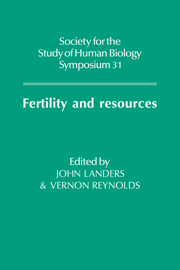Book contents
- Frontmatter
- Contents
- List of contributors
- 1 Introduction
- 2 Environmental and social determinants of fecundity in primates
- 3 Biological aspects of fertility among Third World populations
- 4 A preliminary report on fertility and socio-economic changes in two Papua New Guinea communities
- 5 The cultural context of fertility transition in immigrant Mennonites
- 6 Inter-relationships between consanguinity, religion and fertility in Karnataka, South India
- 7 Resources and the fertility transition in the countryside of England and Wales
- 8 Fertility decline and birth spacing among London Quakers
- 9 Population growth, innovation and resource exploitation
- 10 Fertility decline in developing countries: the roles of economic modernization, culture and Government interventions
- 11 Understanding recent fertility trends in the Third World
- 12 Monogamy, landed property and demographic regimes in pre-industrial Europe: regional contrasts and temporal stabilities
- Index
9 - Population growth, innovation and resource exploitation
Published online by Cambridge University Press: 13 March 2010
- Frontmatter
- Contents
- List of contributors
- 1 Introduction
- 2 Environmental and social determinants of fecundity in primates
- 3 Biological aspects of fertility among Third World populations
- 4 A preliminary report on fertility and socio-economic changes in two Papua New Guinea communities
- 5 The cultural context of fertility transition in immigrant Mennonites
- 6 Inter-relationships between consanguinity, religion and fertility in Karnataka, South India
- 7 Resources and the fertility transition in the countryside of England and Wales
- 8 Fertility decline and birth spacing among London Quakers
- 9 Population growth, innovation and resource exploitation
- 10 Fertility decline in developing countries: the roles of economic modernization, culture and Government interventions
- 11 Understanding recent fertility trends in the Third World
- 12 Monogamy, landed property and demographic regimes in pre-industrial Europe: regional contrasts and temporal stabilities
- Index
Summary
The most important link between population growth and economic development is provided by the reductions in communication and transport costs which follow from increases in population density. Where population size is small improvements in labour productivity are impeded because limited numbers restrict the possibilities for labour specialization outside the family. Specialized producers of consumer goods, agricultural equipment, and services cannot earn a living where villages are small and widely scattered, but as population density increases, and villages become larger and more closely spaced, so the market becomes big enough to support a variety of different types of artisans and performers of specialized services. This development is crucially important because it is only specialized producers who can draw the full benefits of learning by doing, or make economic use of specialized equipment and specialized, full-time, training and education. Thus, agricultural productivity increases as some of the inputs improve in quality, and the advantages so gained are shared by agricultural and non-agricultural producers (Boserup, 1988).
Increases in population allow transport facilities to be improved, and costs to be reduced, because of the growth in the local labour force and in the volume of demand. When regional population densities pass a certain threshold, villages may become linked together by road networks giving them access to a wider market at lower costs. Unless the area is situated a very long way from more developed regions, communications with the outside world will also become more frequent, facilitating the transfer of technology.
- Type
- Chapter
- Information
- Fertility and Resources , pp. 118 - 125Publisher: Cambridge University PressPrint publication year: 1990
- 3
- Cited by

